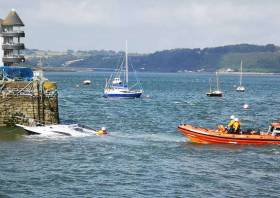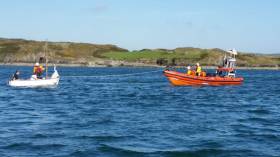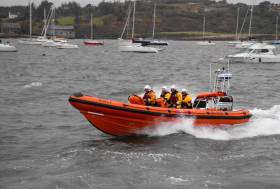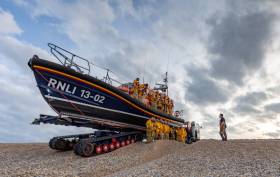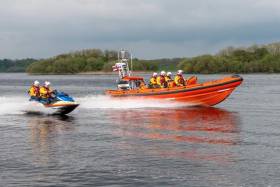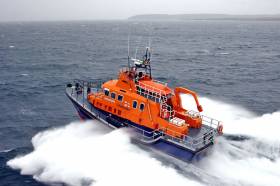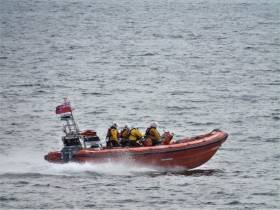Displaying items by tag: Lifeboats
Skerries Lifeboat Tasked To Capsized Currach
Skerries RNLI launched to the rescue of a man and two teenagers in the water after their currach capsized off the north Co Dublin town yesterday evening (Saturday 21 September).
Just after 5pm, Dublin Coast Guard picked up a Mayday transmission from the 14ft currach. Skerries RNLI says that at first the location was unclear.
But several 999 calls from concerned onlookers confirmed that it was near the port lateral marker, known locally as the Perch Mark, just off the headland in Skerries.
The volunteer RNLI crew launched their Atlantic 85 inshore lifeboat Louis Simson to the stricken vessel, which could be seen from the lifeboat station.
Arriving on scene at the same time as the Irish Coast Guard helicopter Rescue 116, the crew learned that Skerries Sailing Club’s tender had also picked up the Mayday and, together with another local angling boat, had taken the man and teenagers from the water.
The casualties were then transferred to the lifeboat and brought ashore and to dry off and warm up. Dublin Fire Brigade paramedics attended to give first aid before a HSE ambulance arrived and gave the trio a full checkover.
Meanwhile, Skerries RNLI reports that the capsized currach was returned to the beach and the oars and other items lost overboard were recovered.
“Accidents can happen at sea at any time,” said Skerries RNLI press officer Gerry Canning. “Everyone on board was wearing a lifejacket, and they had a waterproof VHF to raise the alarm, which is really encouraging to see.
“This was a great team effort across multiple different emergency services with everyone playing their part. We’d also like to commend the young man driving the boat for Skerries Sailing Club and the local angling boat for their swift actions.”
Youghal Lifeboat Called To Vessel Sinking In Harbour
A boat sinking on its moorings at Youghal Harbour in East Cork prompted a callout for the local RNLI volunteers yesterday afternoon (Friday 20 September).
Only the bow of the 24ft boat was visible when the lifeboat crew arrived. A towline was set up and the vessel was brought as close to the pier as possible on the falling tide.
With assistance from the local coastguard unit, the boat was secured with two rides for the owner to attend too at low tide, Youghal RNLI reports.
Baltimore Lifeboat Launches To Sailing Vessel Ashore On Island
Two people were rescued by Baltimore RNLI yesterday afternoon (Thursday 19 September) after their sailing dinghy was stranded ashore on Spanish Island near the West Cork harbour.
The inshore lifeboat was on scene within minutes, and quickly established a tow to take the 14ft vessel off the rocks, Baltimore RNLI says.
After checking for damage, the sailboat and its sailors were bought back to the safety of the pier in Baltimore.
Speaking after the callout, Baltimore RNLI press officer Kate Callanan said: “The sailors did the right thing in asking for assistance as they were unsure of how to proceed once the boat had gone ashore.
“They were both wearing lifejackets and were carrying mobile phones which they used to call the coastguard to alert them of their situation.
:If you get into difficulty on the water or along the coast, call 999 or 112 and ask for the coastguard.”
A motorboat that became propped up on pot buoys in Baltimore Harbour at the weekend made a direct call for help to the local RNLI’s all-weather lifeboat which was returning to base nearby.
The incident occurred on Saturday evening (7 September) after the Baltimore lifeboat had just completed a training exercise with the Irish Coast Guard’s Waterford-based helicopter Rescue 117.
Lifeboat press officer Kate Callanan said: “The skipper of the motorboat realised immediately that he needed assistance and as he had been watching the lifeboat and helicopter demonstration minutes before, he knew that the quickest way to alert the lifeboat was to call them directly on channel 16 on his VHF.”
Within minutes the all-weather lifeboat — with coxswain Kieran Cotter, mechanic Cathal Cottrell and crew members Emma Lupton, Ronnie Carthy, David Ryan, Jim Griffiths, Ryan O’Mahony and Eoin Ryan — was alongside the 33ft motor vessel.
Another motorboat skippered by former lifeboat crewman Torsten Marten was also nearby at the time, and he was drafted to assist in transferring two lifeboat crew to the casualty vessel rather than having to launch the lifeboat’s Y-boat.
The casualty boat was then secured alongside the all-weather lifeboat and brought to the safety of Baltimore’s North Pier.
Callanan reminded all boaters: “It is vital for anyone going to sea to always carry a means of communication such as a mobile phone or VHF in order to raise the alarm should they require help.”
The callout came on the eve of Baltimore RNLI’s centenary celebration yesterday (Sunday 8 September), at which it named its new Atlantic 85 inshore vessel 100 years to the date since the arrival of its first ever lifeboat.
Elsewhere, Skerries RNLI launched on Thursday night (5 September) to tow a razor fishing boat with two on board that struck rocks off Red Island and damaged its steering.
Baltimore RNLI To Name New Inshore Lifeboat On Centenary Of First Lifeboat’s Arrival
Baltimore RNLI’s new Atlantic 85 lifeboat will be officially named Rita Daphne Smyth during a ceremony at the North Pier at 3pm this Sunday 8 September.
As part of the station’s centenary celebrations, the lifeboat, which was placed on service earlier this year, will be officially named exactly 100 years on from the day the first lifeboat, The Shamrock, arrived in the West Cork coastal village.
The RNLI says the new lifeboat has been funded by a generous legacy from the late Rita Daphne Smyth and replaces the station’s Atlantic 75 class lifeboat Alice and Charles.
The Atlantic 85 is the latest version of the B class, introduced into the fleet in 2005 — powered by two 115HP engines and with a stronger hull and greater top speed.
The self-righting vessel comes with radar and a full suite of communication and and navigation aids, as well as a searchlight, night-vision equipment and flares for night-time operations.
Tom Bushe, Baltimore’s lifeboat operations manager said that to receive and name a new lifeboat during the station’s centenary celebrations was something special.
“Our volunteers and the Baltimore community are delighted and excited to name our new inshore lifeboat exactly 100 years on from the day the very first lifeboat arrived at our station. We are most grateful to the late Rita Daphne Smyth for her generous legacy which has funded our lifeboat.
“Volunteers from the local community have been crewing a lifesaving service here for 100 years and we will be proud custodians of this new lifeboat, which will go on to rescue and save many more lives in the years ahead.”
When Baltimore saw The Shamrock begin service in 1919, it was the fourth lifeboat station in Co Cork. Since then, Baltimore RNLI’s lifeboats have launched more that 940 times and their crews have rescued 867 people including 280 lives saved.
The Shamrock remained in service until 1950 when a new Watson class lifeboat, Sarah Tilson, was placed on service. In 1978, the Sarah Tilson was replaced by another Watson class lifeboat called The Robert, which was replaced six years later was replaced by an Oakley class lifeboat called Charles Henry. In February 1988, a new Tyne class lifeboat, Hilda Jarett, was placed on service.
In April 2008, a second lifeboat, an inshore Atlantic 75 called Bessie, joined the station to complement the existing all-weather lifeboat. In February 2012 a new Tamar class lifeboat, Alan Massey, replaced the Hilda Jarrett.
In July the following year a complete refurbishment of the lifeboat house was finished, leaving the station with state-of-the-art facilities.
Photographer Jack Lowe Tours Northern Ireland In Bid To Capture Every RNLI Lifeboat Station With Victorian Camera
Nearly five years into his epic project to photograph every RNLI lifeboat station with a Victorian-era camera, Jack Lowe this week began the Northern Ireland leg of the mammoth undertaking.
Starting yesterday (Tuesday 3 September) at Red Bay, Lowe’s four-week swing also includes Portrush tomorrow (Thursday 5 September), then Enniskillen, Carrybridge, Newcastle, Kilkeel, Portaferry, Donaghadee, Bangor and Larne before he returns home to Newcastle-upon-Tyne — via Portpatrick and Stranraer in Scotland.
Lowe will capture each lifeboat station and its crew using wet plate collodion, a process developed in the 1850s — when the RNLI also began — that creates stunning images on glass.
Following this 19th leg, the end of The Lifeboat Station Project will be in sight as the remaining station count will be down to double figures.
When completed, The Lifeboat Station Project will be the very first time every station on the RNLI network been documented as one complete body of work. It is also one of the biggest photographic projects ever undertaken, the RNLI says.
As with the rest of his adventure, Lowe travelled to Northern Ireland on Monday (2 September) with ‘Neena’, a decommissioned NHS ambulance purchased on eBay, which he converted into a mobile darkroom.
Along the way Lowe has been sharing the ups and downs of his mission on social media. He also makes videos and sound recordings, enabling his followers to get a real sense of what life is like within lifeboat communities.
Almost a year ago, Lowe reached the halfway mark of his epic project that previously took him to Ireland’s South Coast, where he completed his 100th station in Valentia.
By the end of September 2018, he estimates to have used around 1,500 glass plates, 120 litres of developer and 45 litres of collodion.
Lowe had also driven some 28,000 miles — the equivalent of more than once round the world.
“It’s a privilege spending time with so many lifeboat volunteers, preserving their bravery and devotion for future generations,” Lowe says.
“This journey is unprecedented in so many ways. The further I travel, the deeper the body of work becomes on just about every level and in ways that I could never have foreseen or imagined.”
The Lifeboat Station Project’s dedicated website has links to Lowe’s Facebook, Twitter and Instagram feeds, as well as his Patreon campaign.
Busy Weekend For Northern Ireland Lifeboats As Summer Season Ends
Northern Ireland lifeboat crews marked the end of the summer season with a number of callouts over the weekend.
On Saturday afternoon (31 August) Portaferry’s inshore lifeboat wad called out to reports that two Flying Fifteen keelboats had capsized on Strangford Lough.
On arrival it was found both vessels had been righted and were returning to shore, Portaferry RNLI said.
But while out on the lough, the lifeboat crew were also tasked to aid a 36ft yacht which had run aground on Don O’Neill Island some four miles away.
At the scene, the lifeboat crew ensured that all on the yacht and their dog were safety aboard their vessel and that there was no water being taken on.
The following afternoon (Sunday 1 September), the inshore lifeboat launched to a motorboat with two adults and three children that had run aground in the Narrows.
Another vessel had taken the casualty boat under tow to deeper water and the lifeboat crew followed up by escorting the motorboat to Portaferry Marina.
Elsewhere on Sunday, Carrybridge RNLI’s inshore lifeboat and rescue water craft were launched to a vessel with four on board which had grounded west of the Share Centre on Upper Lough Erne.
After carefully navigating the shallow waters and assessing the condition of the two adults and two children on board, the lifeboat crew checked the vessel for water ingress and none was found.
With the owner’s permission, the volunteer crew set up a tow line and proceeded to refloat the casualty vessel in deeper water.
The barge was again checked for water ingress and the steering and propulsion also checked before they were allowed to continue their journey.
Carrybridge lifeboat operations manager Stephen Scott reminded all boaters to plan their routes carefully using revenant charts to avoid difficulties in unexpectedly shallow waters.
Five people were rescued off North Co Antrim yesterday afternoon (Friday 30 August) when their 33ft yacht got into difficulty near Rathlin Island.
Red Bay RNLI’s volunteer crew were requested to launch their all-weather lifeboat 1.20pm following a report that the yacht was struggling to make headway in difficult conditions at sea some five miles south-east of Rathlin.
Two of the crew onboard the yacht — which was on passage to Carrickfergus — were also suffering from seasickness, Red Bay RNLI says.
The lifeboat crew set up a tow and brought the vessel to Ballycastle. Speaking later, Red Bay RNLI press officer Paddy McLaughlin said: “Conditions at sea were challenging this afternoon and the crew made the right decision to call for help.”
Elsewhere, Clifden RNLI in Connemara launched its new all-weather lifeboat for the first time on Thursday afternoon (29 August) to reports of a RIB adrift and in danger in Ballinakill Bay between Letterfrack and Renvyle.
However, it was the D class inshore lifeboat Celia Mary which was first on the scene — where volunteers found two people on a 5.5m RIB with engine failure that was very close to the rocky shore in worsening weather conditions, with a Force 6 wind at the time.
Lifeboat helm Thomas Davis agreed with the two people on board the RIB that the vest course of action was a tow back to shore, which was safely completed.
Davis said: “We were glad to be able to help these people recover their boat today.
“We also wish to remind all water users in Connemara to contact the coastguard or emergency services at the earliest opportunity when things go wrong — we would always rather launch and be stood down than risk other possible outcomes.”
Two Medical Evacuations For Aran Islands Lifeboat On Wednesday
Two people were evacuated from the Aran Islands for medical reasons by the area’s RNLI lifeboat yesterday (Wednesday 28 August).
At 4.50pm the all-weather lifeboat David Kirkaldy called to launch from Inis Mór to neighbouring Inis Meain where an elderly man had been injured in a fall.
Under coxswain John O’Donnell and a full crew onboard, the Severn class lifeboat braved difficulty conditions, with choppy 1.5-metres seas and Force 5-6 west to south-westerly wind, to transfer the casualty to the waiting ambulance in Rossaveal.
Later in the evening, just after 11pm, the volunteer crew were called out for another medevac, this time to a sick man elsewhere on Inis Mór who required further treatment, Aran Islands RNLI says.
Despite the even worse conditions at sea, the man was safely transferred to Rossaveal and the waiting paramedics.
O’Donnell said later: “Yesterday was a busy one for the volunteer crew members but they are always ready to answer the call and happy to help out. We would like to wish both patients a speedy recovery.”
Kilkeel Lifeboat Races To Speedboat Breakdown In Carlingford Lough Busy With Shipping
Kilkeel’s volunteer lifeboat crew worked fast to help clear a speedboat with engine troubles from a busy shipping lane yesterday afternoon (Tuesday 27 August).
The 16ft Bayliner, with one person on board, had broken down in Carlingford Lough and was in danger from incoming and outgoing shipping traffic, according to Kilkeel RNLI.
Kilkeel’s inshore lifeboat launched at 1.10pm headed south along the Co Down coast, and on arrival at the scene they found that the speedboat has been restarted.
Checking that the skipper was fine, they ensured there were no further issues before escorting the skipper back to his mooring in Greencastle.
The previous evening, Carrybridge RNLI’s inshore lifeboat Douglas Euan & Kay Richards and rescue water craft were launched to a vessel with its own engine difficulties some two miles downstream of the River Erne hamlet.
When the lifeboats arrived on scene, the casualty vessel — with two person on bard — was found floating close to the shoreline.
Once those on board were found to be well, a volunteer from the rescue water craft boarded their vessel to help set up a tow line and it was brought back to its private berth in the hamlet.
Carrybridge RNLI helm Chris Cathcart later advised all boat users: “Before setting out on your journey, please plan your route and carry out regular checks of their vessels. Also have a means of calling for assistance if you find yourself in trouble.
“If you see someone in trouble on the water or are in difficulties yourself, the number to dial is 999 or 112 and ask for the coastguard.”



























